Some of the links in this post may be affiliate links.
Do you have a wilting, limp or drooping peace lily? Are you utterly confused and frustrated as to why this is occurring? I’ve helped a lot of my clients and readers resolve their issues by getting to the real cause of the issue. But the fact is that there are a LOT of reasons why your peace lily could be drooping.
I will help you determine exactly why your peace lily is drooping and also learn how to fix it. Unless your plant has stayed severely wilted for a long time, there is hope. With attention and consistent care, you can have a beautiful plant once again.
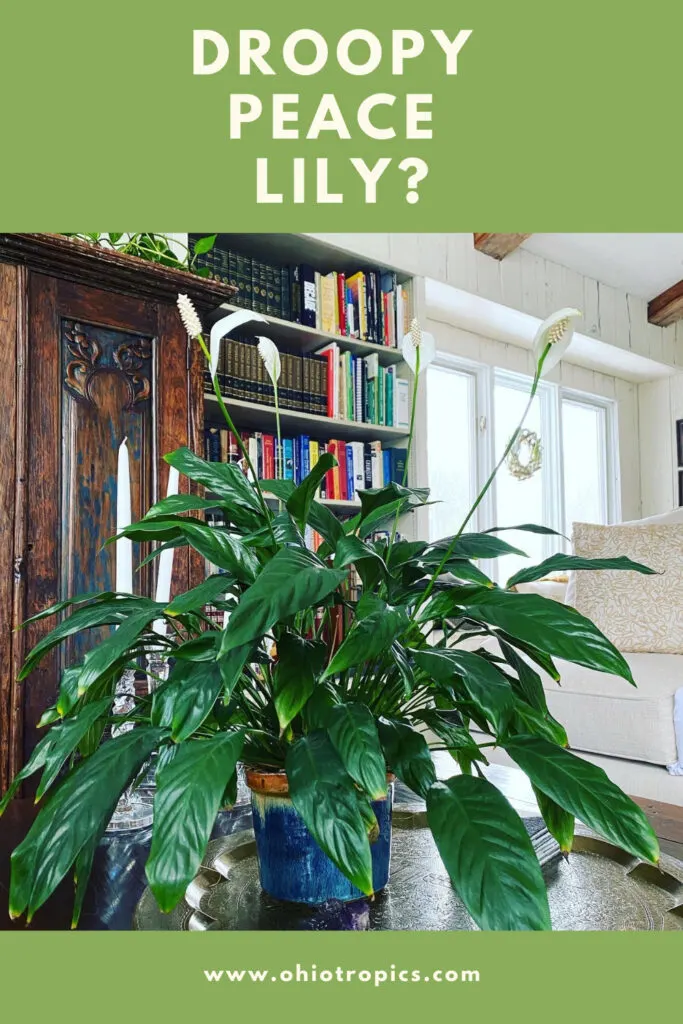
Table of Contents
DROOPING PEACE LILY: 11 REASONS
In order to get the full benefit, I would recommend reading through this entire post versus selectively picking what you think is wrong with your plant. You are bound to pick up some good knowledge by reading everything through completely because I touch on a number of important topics.
And in some cases, you can have more than one cause at play! Now let’s get into it.
1. Potting mix is too dry
If you are reading this post, chances are you’ve done this (as have I!) Peace lilies are moisture loving plants and when they go completely dry, they will protest and wilt and droop.
Go ahead and feel your potting mix. Is it completely dry? Lift your pot. Does it feel really light?
Solution: Go ahead and give your plant a very thorough watering. If you can, bring your plant to your sink or bathtub. If you notice that water is going straight through very quickly, continue to soak your plant until the potting mix has accepted moisture again.
Sometimes when your soil or potting mix get too dry, it takes a little bit of work to moisten it back up, but it is important that you do this otherwise you will keep repeating the cycle.
After a good thorough watering, your plant should recover fairly quickly, in a matter of hours (depending on how droopy it is).
One last tip, do not use a moisture meter to tell you when to water. They are notoriously unreliable and I’ve known many people that have killed their plants because the reading was eternally on “moist” even though the potting mix had gone completely dry.
I feel so strongly about this that I wrote a post on the dangers of soil moisture meters.
In short, use your finger to feel the potting mix, and water after the top inch of soil has dried out.
2. Potting mix is too wet
Is your peace lily drooping but your soil is moist? The confusing part about plant care is often that opposite conditions (too dry or too wet) will cause the same issue, in this case, drooping. The key is that you must observe your own plant.
If your peace lily is drooping and your soil is still moist (make sure you feel the potting mix with your fingers to confirm), then chances are that your plant has stayed too wet for too long.
Solution: Determine why your potting mix has not dried out. Is your plant sitting in water? (Either in the saucer underneath, or perhaps in the cachepot or decorative pot that your plant is sitting in?) Lift your plant up. Is there any pooled water? If so, discard it.
Or perhaps your plant is sitting in a very dark location, the pot is too big, or any combination of everything I just mentioned. These will all slow down the rate at which your soil dries out.
Allow your potting mix to dry out a bit by addressing any of the issues just mentioned and then see if it recovers. If it doesn’t, then it probably has pretty bad root rot, which takes us to the next section.
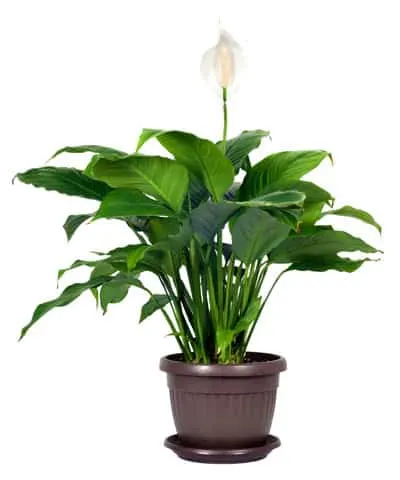
3. Root rot
If your potting mix is water-logged and stays too wet for too long, it creates a lack of oxygen at the root zone. This creates a favorable environment for certain microorganisms to attack your plant’s roots, resulting in root rot. Let’s say you suspect root rot and you know your soil has stayed wet for a long time and you’ve observed your plant is droopy.
At this point, you can implement some of the measures in item #2 above. If your potting mix dries out and your plant is still droopy, it’s time to take further action.
Solution: Determine why your potting mix stayed wet. Was the pot much too big for the plant? Did you allow the plant to sit in water for too long? Take the plant out of its pot and observe the roots.
If they suffered from root rot, they will be mushy and may even smell. Remove any mushy roots and repot your plant. It may need to go in a smaller pot than before if much of the root system has rotted out.
4. Too hot or too much direct sun
Spathiphyllum or peace lilies are native to humid, tropical forests. They generally grow and thrive in moist, shady forest floors. This doesn’t mean that extreme heat or a lot of direct sun is welcome. Has your plant been exposed to a lot of direct sun or unusually hot conditions? Perhaps hot temperatures in an enclosed car while taking your plant home?
Solution: Avoid extremes in temperature and too much direct sun. If you are comfortable temperature-wise, your plant will be too. Avoid too much heat from vents, enclosed spaces, and avoid extended periods in direct sun, especially mid-day sun which is strongest. A couple hours of direct sun in early morning or late afternoon is gentle enough for these plants.
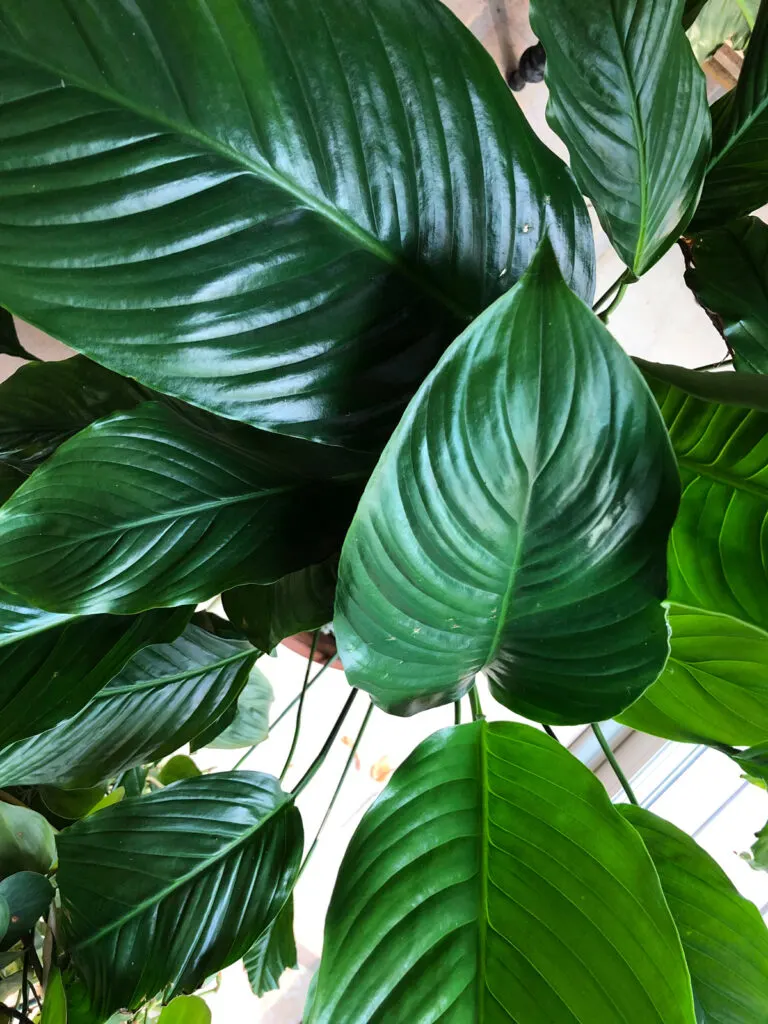
5. Too cold
Drooping can also occur if your plant has been exposed to cold temperatures. Peace lilies in general like temperatures between 65F-85F (18-24C). A drop in nighttime temperature is fine, but avoid exposing your plants to temperatures below 55F (13C). Keep this in mind if you move your plants outdoors.
Solution: Avoid drafty, cold windows (especially if you live in a cold winter climate). Avoid transporting your plant in cold weather unless you can provide adequate protection and can make the move quickly. If you’re moving your plants outdoors at all, make sure to keep an eye on the weather forecast.
6. Your plant is root-bound
This is an important one to discuss. If your peace lily is severely root-bound, it will make it more prone to dry out very quickly, which can lead to droopy leaves and wilting. Are you finding yourself watering a lot more frequently than you used to? Are there perhaps roots coming out of the drainage hole, and maybe even a lot of surface roots matted on top? It may be time to repot.
Solution: Take your plant out of the pot and look at the root system. If it is root-bound like my plant below, it’s time for a new pot! Loosen the root ball a bit, and give it a slightly larger pot.
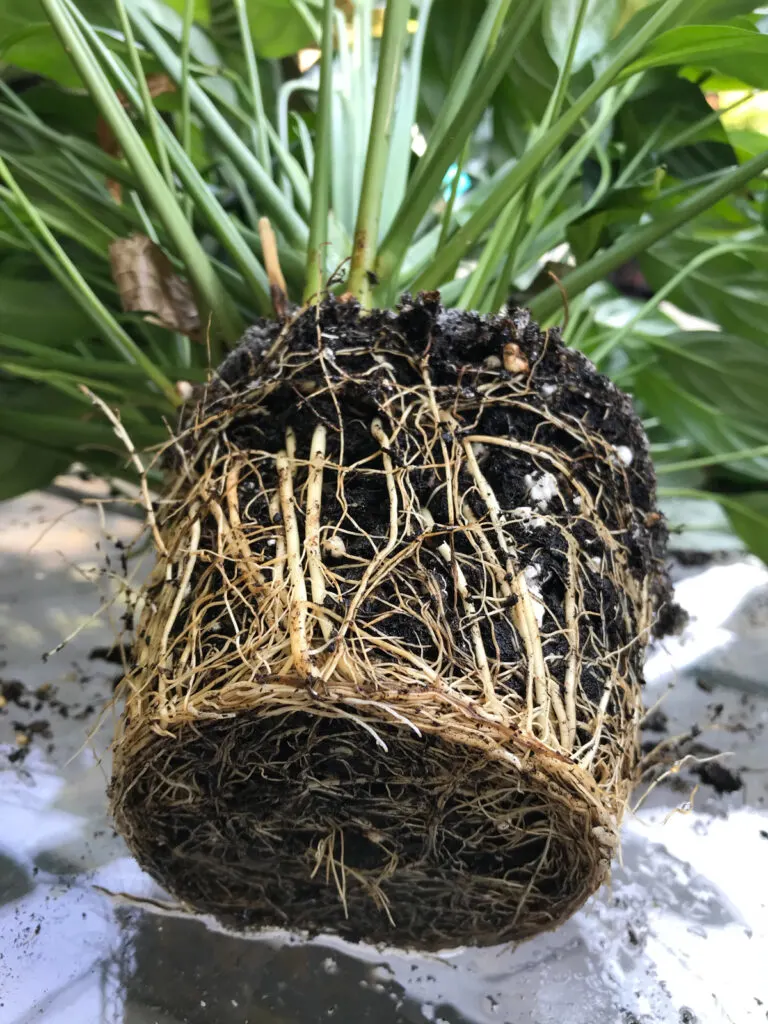
7. Improper repotting
Is your peace lily drooping even after repotting? Knowing how to properly repot is very important. Was your plant severely root-bound and you failed to loosen the root ball before placing it in its bigger pot? If so, your plant’s roots will have a hard time growing into the new potting mix. In addition, there will also be less, fresh potting mix surrounding the roots so it will be much more difficult to keep your roots hydrated.
Solution: Make sure that you loosen your root ball before you repot. This will allow more roots to have contact with your potting mix, which you want.
Before I repot any plant, especially if it’s severely root-bound, I like to first give it a nice thorough watering. After a few hours, or even the next day, I’ll then take it out of it’s pot. I’ll first tease the roots loose at the bottom, and then work my way around the perimeter.
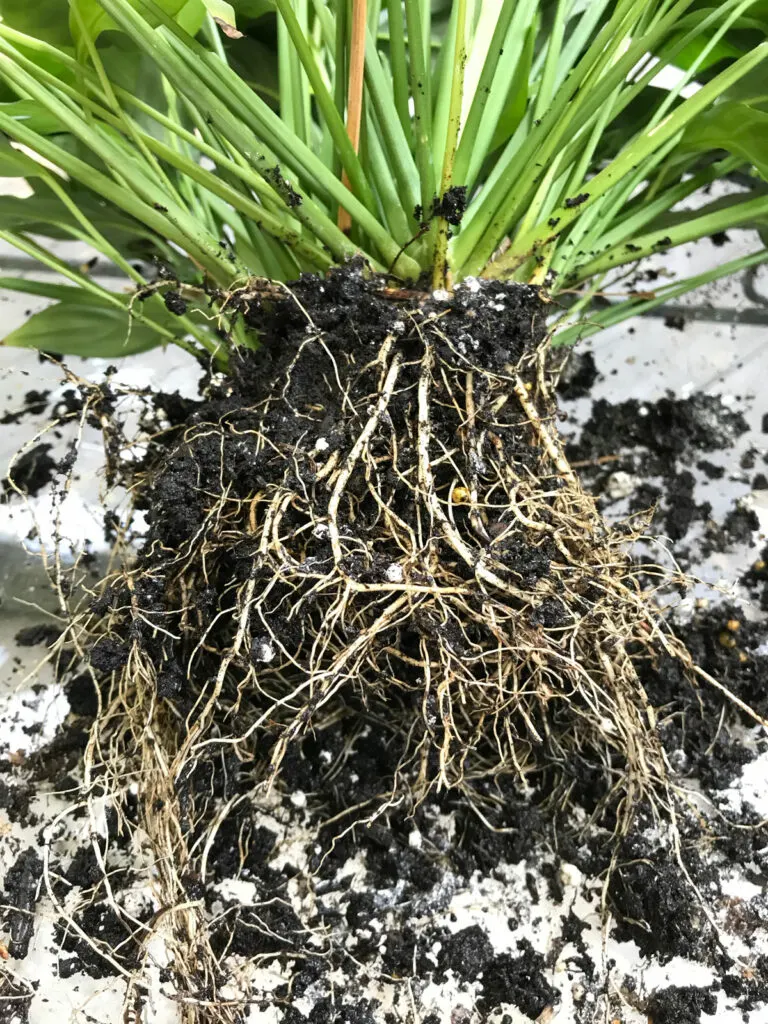
Many years ago, out of laziness, I did not loosen the root ball. I had a severely root-bound peace lily and I simply placed it in a new pot without touching the root ball at all. A couple years later, the plant still was not growing much at all. I decided to take it out of the pot and not a single new root had grown into the potting mix.
I then proceeded to loosen the root ball, and planted it back in the pot. Growth then took off and the plant started to flourish.
If you’ve repotted your peace lily and it’s looking very sad right after…be sure to carefully read my blog post: Peace Lily Dying After Repotting? Reasons You Never Knew.
8. Improper watering practices
This is a big one and a mistake that I’ve seen many people make. Are you one of those people that are terrified of “overwatering“? Your fear of overwatering can make your situation much worse. I’ve had so many people tell me that they use measured amounts of water (often times just 1/4 cup, or something similar) because they don’t want to “overwater”.
This is not the way to water. If you’re not thoroughly moistening all of your soil, the roots in any dry pockets of soil will eventually dry out and your root system’s health will decline. Once your root system declines, so will your plant and it will droop and not be able to support all of the foliage that it previously had.
Solution: Always water thoroughly! Thoroughly moisten all of the potting mix and keep watering until water escapes the drainage hole(s). Discard any excess water, and you’re done. Peace lilies like to stay moist at all times for best growth. If you can, only allow the top inch or so of the potting mix to dry out, and then water. Consistent care will result in a beautiful, healthy plant.
9. Humidity is too low
This is a more minor one, but nonetheless, this can also cause some slight drooping. Really low humidity can also cause the edges of leaves to turn yellow and leaf tips to turn brown.
Solution: Peace lilies are humidity-loving forest dwellers in the tropics. It’s always a good idea to increase your humidity, especially during periods of dry air in the winter if you run forced air heat like I do. The best way to increase humidity is to invest in a good humidifier. I’ve personally reviewed 3 wonderful humidifiers to help you out if you aren’t sure which is best!
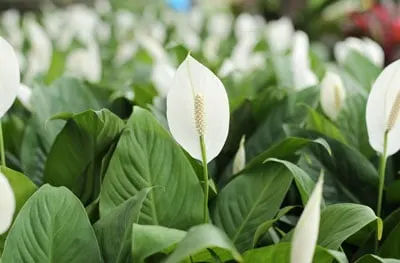
10. Pests
Normally, peace lilies seem to be pretty pest resistant. If they do encounter any pest issues, it will likely be mealybugs. They’ll typically appear as white cottony masses on your plant. Like many pests, mealybugs suck sap out of your plant, and if the mealybug population is left unchecked, this will lead to drooping as well as yellow leaves.
Solution: Mealybugs, like any pests, are best treated before they get out of control. A good
11. Poor potting mix
Using the wrong potting mix can cause issues with your plant. Mixes that exhibit very poor drainage, are too dense or heavy, or that dry out too quickly, can all cause issues with being able to maintain the appropriate soil moisture, and cause drooping to some extent.
Solution: In order to manage your peace lily’s soil moisture, use a light, all-purpose well-draining potting mix. Avoid any mixes meant for succulents/cacti as these can dry out too quickly. I like to use an all-purpose mix such as Miracle-Gro or Espoma. I use about 3 parts of one of these mixes plus 1 part perlite.
That wraps it up! Please refer to my post for general care of peace lilies for more information. Hopefully you’ve been able to determine the cause of your drooping peace lily. Comment below. I’d love to hear!


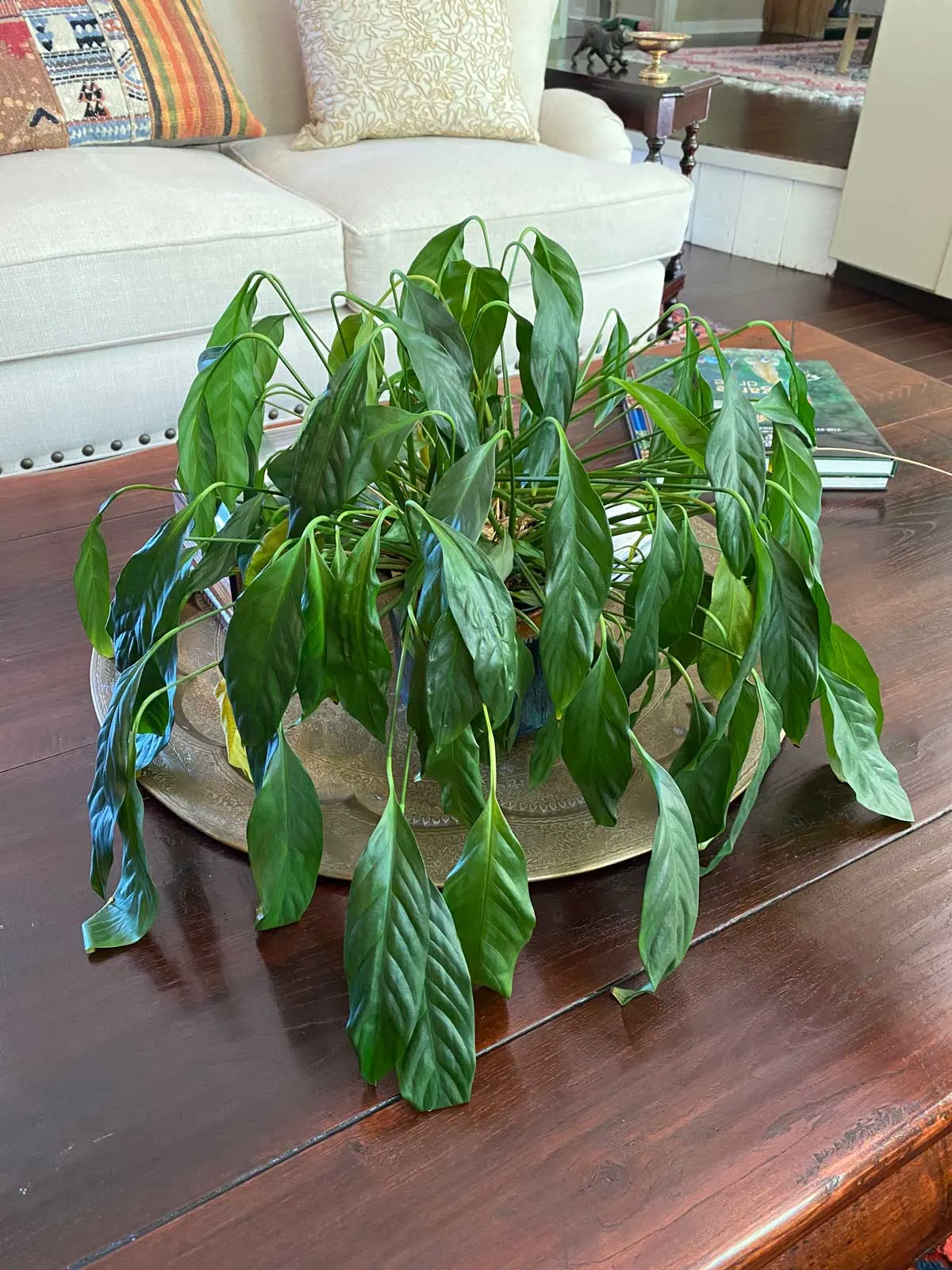
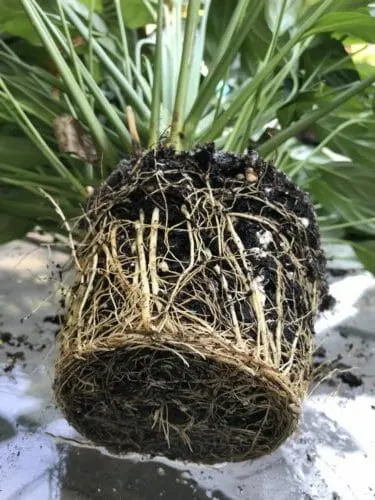
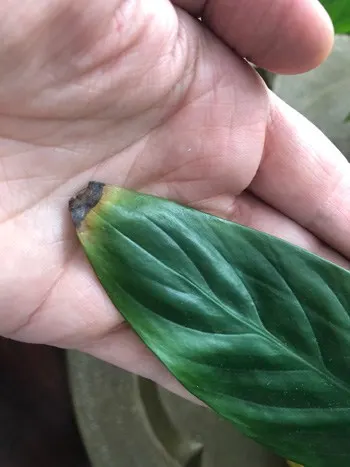
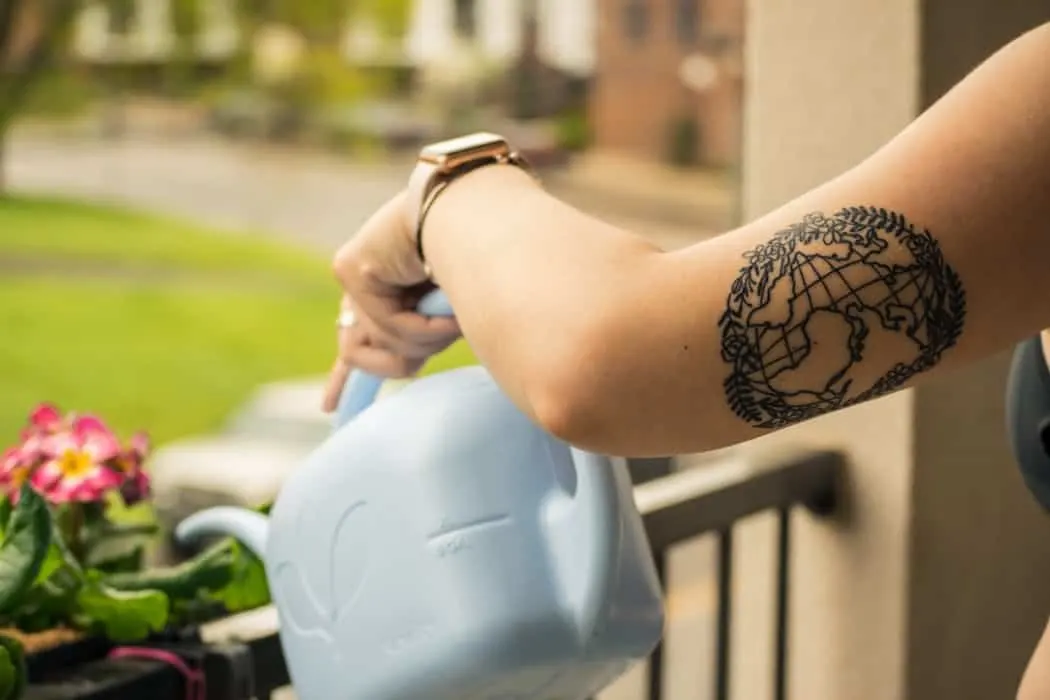
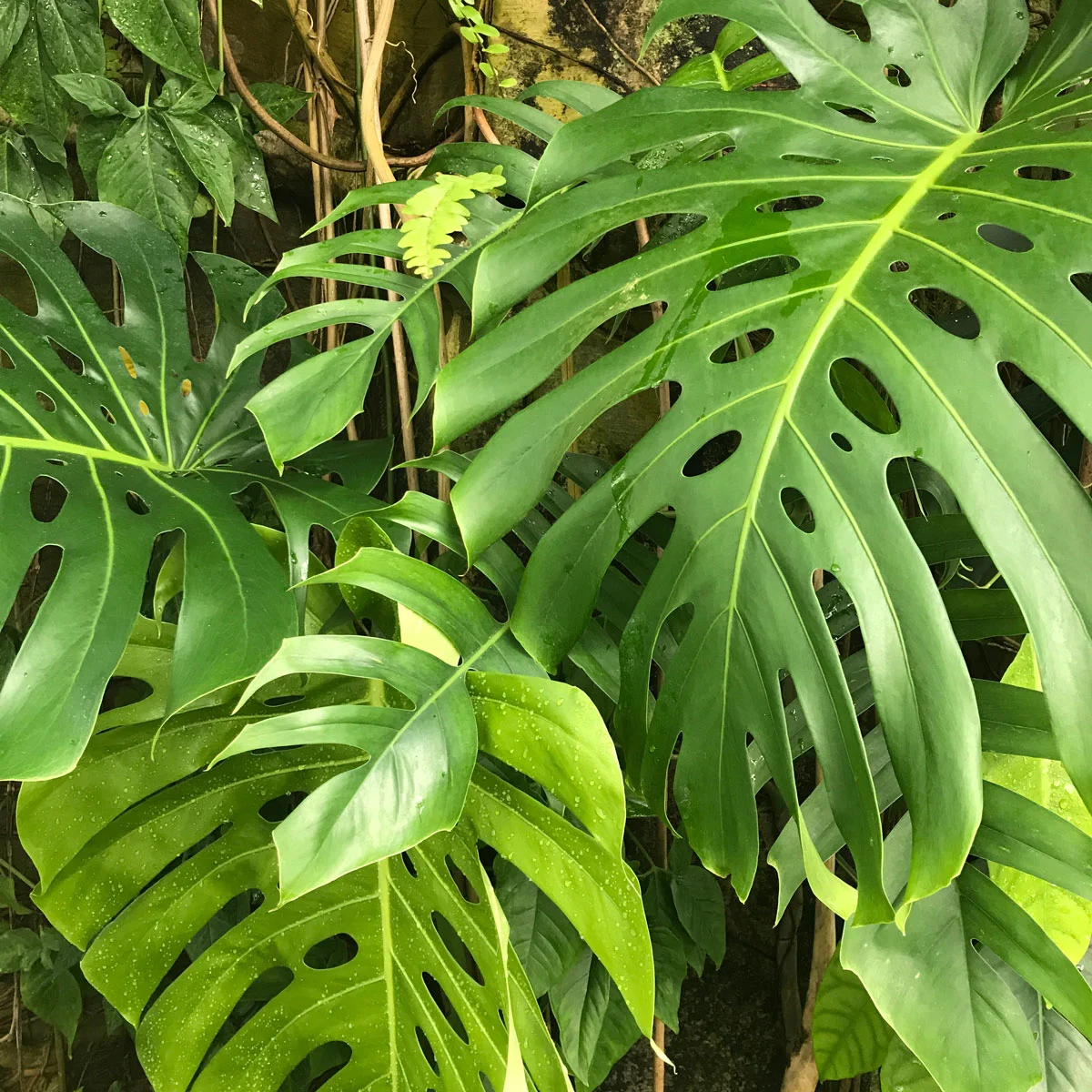
Danielle
Thursday 12th of May 2022
Your articles are so informative, thank you. I'm not sure what is wrong with my peace lily though. I received it 4 years ago when my husband passed away and don't want to lose it. I repotted it about two months ago, and all was well until I rotated it and realized a portion of the leaves and stems had fallen. Water didn't help, so I started researching. Thinking it was potentially root rot, I pulled it from the pot, separated most of the fallen crowns and repotted back in the smaller pot with new soil. It's only been a few days, but parts are still extremely wilted and laying on the side of the pot. I don't know if I should wait longer or check again to see if there is more rot? I don't want to stress it more, but also don't want to wait too long and it die more. Any recommendations? Thanks.
Raffaele
Friday 13th of May 2022
Hi Danielle. First off, I'm very sorry to hear about your husband. I actually just published a new blog post where I talk about issues with peace lilies that occur as a result of repotting. Check it out, and let me know if any of that information resonates with you! Here it is: https://www.ohiotropics.com/2022/05/03/peace-lily-dying-after-repotting/
Angie
Tuesday 12th of April 2022
This winter, I decided to fertilize my Spath using Miracle Grow mixed in an empty milk jug. I think I shocked my plants and that it was too much fertilizer! My Fiddle Leaf Fig died and my Spath just went so droopy and the leaves are soft. It’s been 3-4 months. I have been giving distilled water only but it doesn’t fully dry out. About the time I fertilized, we were building fires in the fireplace= low humidity and high heat nearby. I’m wondering if I should just start with a new plant and give up on this one.
Angie Gunsauls
Thursday 14th of April 2022
@Raffaele, thanks for responding! It just doesn’t seem to recover from the wilt. But it’s not dying either. I could send you a picture if that helps. I had the plant on the mantle above the fire. I don’t remember if I measure the Miracle Grow properly. That’s just when the problem started and also when my fig died.
Raffaele
Tuesday 12th of April 2022
Are you sure it was from the fertilizer? Did you measure out the water and fertilizer carefully? If your plants were too close to the fireplace, that could have potentially done it too...I'd need more details to help though.
Nyree
Monday 21st of March 2022
Hi, thank you very much for your tips, I hope they will help my peace lily. Great blog.
Raffaele
Tuesday 22nd of March 2022
Glad you enjoyed it Nyree! Good luck with your peace lily :-)
Tina Elswick
Monday 28th of February 2022
I have a piece Lily I water it every week the soil is fine but I'm having a problem of the leaves turning brown and drying up. I just don't understand what is wrong could you please help me with this
Raffaele
Tuesday 1st of March 2022
This is a common issue and can be caused by a big variety of things. Read this blog post that I wrote and see if anything in that post fits what you are experiencing: https://www.ohiotropics.com/2019/03/31/plant-leaves-brown-and-crispy/
Patsy Carraway
Monday 7th of February 2022
I have a peace lily that sits in a vase of water and a little soil, it came this way. The leaves are turning brown and wilting. Advice?
Raffaele
Monday 7th of February 2022
I would either grow it all in water or all in soil....if it's mixed like you're talking about, it will cause a lot of problems. I would probably plant it in soil and grow it that way.